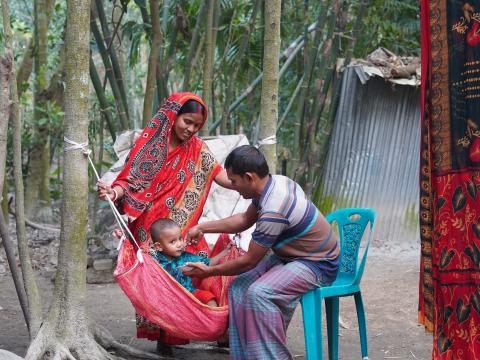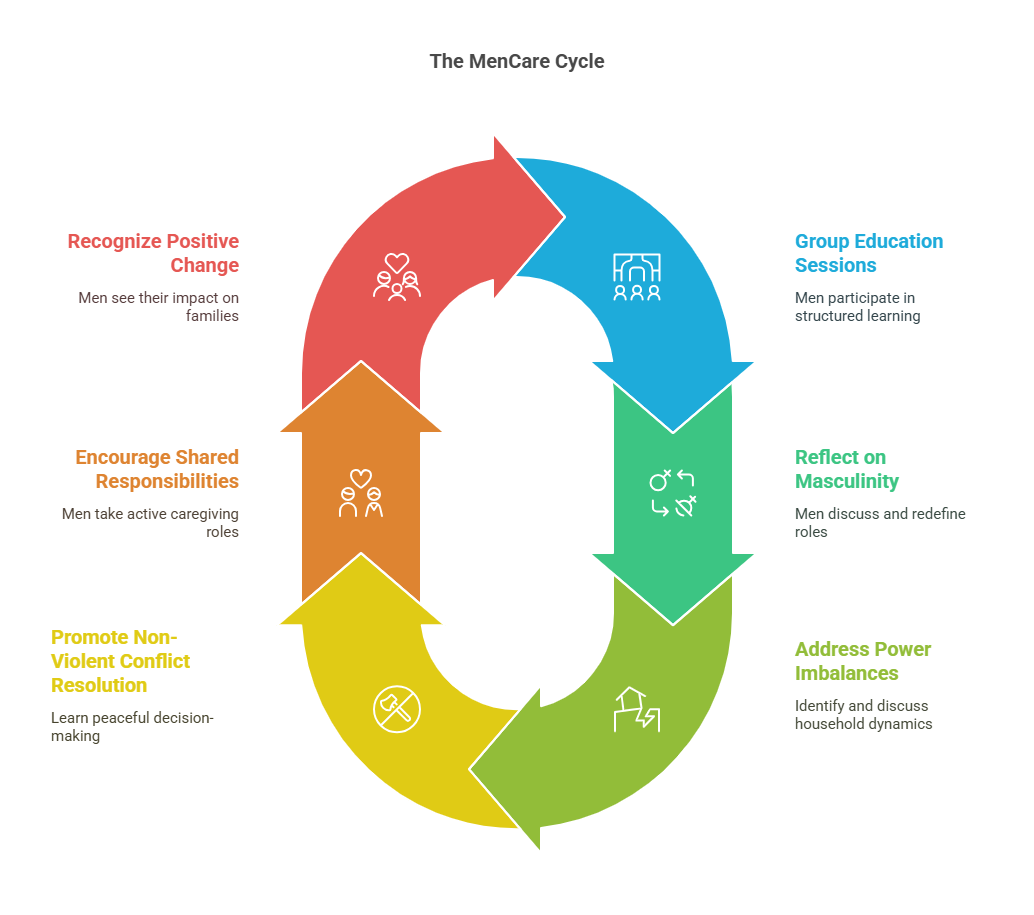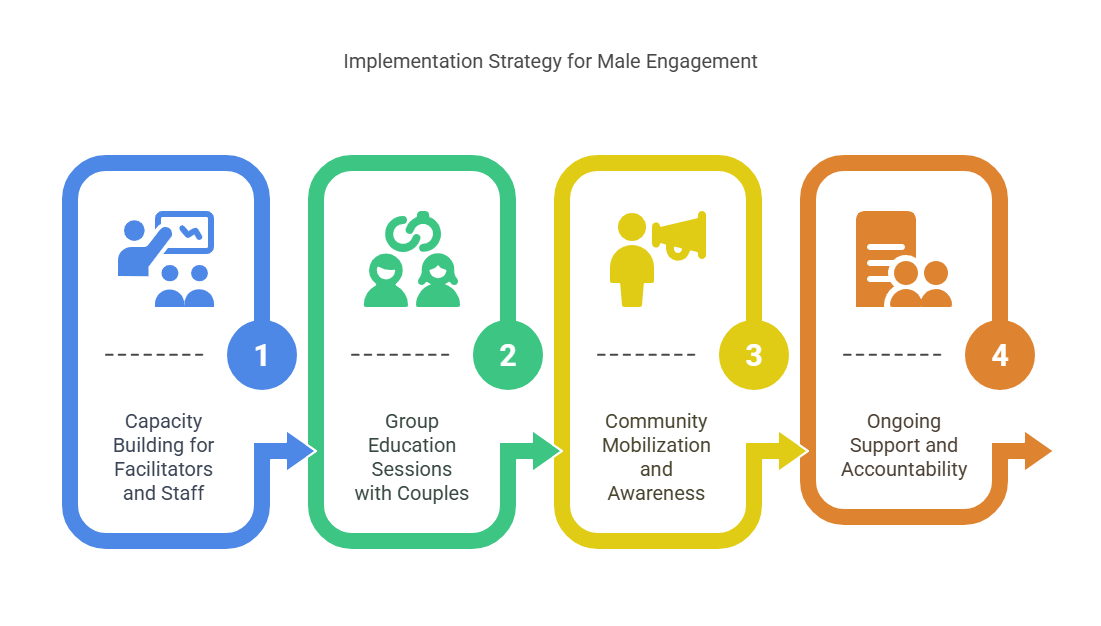The Silent Revolution: How Engaging Men is Transforming Families and Communities

Rethinking the Approach to Gender Equality
For decades, efforts to advance gender equality in Bangladesh have primarily focused on empowering women. While this is essential, experience shows that sustainable change cannot happen without actively engaging men. Gender norms and power structures—deeply ingrained in households and communities—cannot shift if half of the population remains disengaged.
At World Vision Bangladesh, we have learned that male engagement is a missing piece in the fight against gender-based violence (GBV) and gender inequality. The MenCare Approach has emerged as a transformative tool, equipping men to become allies in building healthier families, reducing violence, and fostering shared caregiving responsibilities. The results have been striking—not just in individual households, but in entire communities.
The Persistent Gender Inequality Landscape in Bangladesh
While Bangladesh has made notable progress in improving gender parity in education and employment, key indicators still reveal entrenched inequalities, particularly within households and in preventing gender-based violence.
According to national surveys, a majority of women in Bangladesh continue to experience some form of domestic violence in their lifetime. Many remain silent due to stigma, social pressure, and financial dependence. Troublingly, cultural norms continue to reinforce the belief that men hold decision-making power over women’s lives.
Global rankings also reflect these persistent challenges. The Global Gender Gap Report 2023 places Bangladesh 71st in gender equality, with gaps in economic participation, leadership roles, and workplace inclusion.
These realities underscore the urgency of rethinking how gender equality interventions are designed and implemented. While traditional empowerment programs have yielded progress, it is clear that real transformation requires shifting mindsets, particularly among men.

Men as Partners in Change: The MenCare Approach
The MenCare Approach is designed to challenge harmful gender norms, reduce domestic violence, and encourage men to take an active role in family well-being. Unlike conventional interventions that focus solely on women’s empowerment, this model directly involves men in structured, evidence-based group education sessions.
Through facilitated discussions, men reflect on:
✔Redefining masculinity—moving from dominance to partnership.
✔The impact of power imbalances within households.
✔Non-violent conflict resolution and shared decision-making.
✔Their role in caregiving and household responsibilities.
This participatory model is not about blaming men—it’s about helping them recognize their power to create positive change in their families and communities.
Implementation Strategy: Building a Scalable Model for Change
The success of male engagement hinges on structured implementation, ensuring that changes in attitudes lead to sustainable behavior shifts.
1. Capacity Building for Facilitators and Staff
- A training-of-trainers (ToT) model was adopted, equipping project officers and community facilitators with gender-transformative facilitation skills.
- Community-based peer educators were engaged to sustain learning beyond structured sessions.
2. Group Education Sessions with Couples
- Men participated in guided group sessions alongside their partners, exploring topics such as household decision-making, financial planning, and non-violent communication.
- Mothers-in-law were also engaged to challenge intergenerational norms that reinforce gender inequality.
3. Community Mobilization and Awareness
- Public dialogues, household visits, and mass awareness campaigns were launched to extend the impact beyond participating couples.
- Linkages with local governance structures ensured broader policy alignment and support.
4. Ongoing Support and Accountability
- Post-program follow-ups were conducted to assess whether men continued their engagement in household and community leadership.
- Success stories and best practices were documented to refine and scale the model.
This structured approach ensures that the MenCare model does not end with workshops—it translates into real, measurable change at the household and community levels.

Impact: Transforming Families and Communities
An evaluation of the MenCare Approach in World Vision Bangladesh’s implementation areas revealed significant shifts in male attitudes and behaviors:
✔Conflict resolution improved: Before intervention, only 65.1% of men calmly explained conflicts, while 23.6% resorted to verbal aggression and 7% admitted to physical violence.
- Post-program:96% of men resolved conflicts calmly, with verbal aggression dropping to 3.2% and physical violence to 0.4%.
✔Women’s decision-making power increased:
- Pre-intervention:Only 52% of women had input in financial and family matters.
- Post-intervention:91% of women reported actively participating in decision-making.
✔Attitudes toward child marriage shifted:
- The belief that “women must accept violence to keep the family together” declined from 28.1% to 13.8%.
- Opposition to child marriage rose from 29.8% to 50.1%, as men increasingly recognized the harmful impacts of early marriage.
✔Sustained Community Impact:
- Over time, graduates of the MenCare program have become advocates for gender equality, mentoring other couples and engaging in community-based GBV prevention efforts.
These results demonstrate that gender norms can change when men are given the tools, guidance, and support to be active allies in the fight against GBV.

Lessons from Global Evidence: Why Male Engagement Works
World Vision Bangladesh’s experience aligns with global research showing the power of male engagement in advancing gender equality:
✔ In Brazil, the Promundo Initiative saw a 58% reduction in intimate partner violence among participants.
✔ In South Africa, the Sonke Gender Justice project led to a 38% drop in GBV rates.
✔ In Rwanda, structured male engagement programs reduced violence against women by 60%, with men becoming more involved in childcare and household chores.
✔ In Nepal, combining male engagement with economic empowerment led to a 45% decrease in household conflict within two years.
These success stories reinforce a key lesson—when men are invited into the gender equality conversation, rather than excluded from it, they can become powerful agents of change.
A Story of Change: Rabeya and Solaiman
For Rabeya, gender inequality was a lived experience. Married young, she dreamed of becoming a teacher, but cultural expectations and family restrictions forced her to abandon her aspirations. She endured years of silent struggle, with financial dependence and social norms keeping her trapped.
Everything changed when she and her husband joined the MenCare sessions. For the first time, Solaiman reflected on his role in shaping their family’s future. With structured guidance, he challenged his own biases, took responsibility for household decisions, and encouraged Rabeya to reclaim her ambitions.
Today, Rabeya is employed, financially independent, and actively engaged in community advocacy. Meanwhile, Solaiman has become a vocal supporter of gender equality, encouraging other men to break free from harmful traditions.
Their story is not just one of personal transformation—it is proof that when men and women
Looking Ahead: Institutionalizing Male Engagement for Gender Equality
To sustain and scale the impact of male engagement, World Vision Bangladesh is advocating for policy integration and cross-sectoral collaboration to drive lasting change.
1. Expanding Rehabilitation for GBV Offenders
Bangladesh’s Domestic Violence Act (2010) provides legal protection, but punitive measures alone don’t break cycles of violence. Structured gender-transformative programs should be integrated into rehabilitation centers and community interventions to:
- Equip offenders with non-violent conflict resolution skills.
- Challenge harmful masculinity norms.
- Promote accountability and behavior change.
✅ Next Step: Partner with Ministry of Women and Children Affairs to pilot MenCare-style rehabilitation programs.
2. Embedding Male Engagement in National Policies
Existing frameworks like the National Women’s Development Policy (2011) focus on women’s empowerment but lack male-targeted GBV prevention strategies.
- Integrate male engagement into the National Action Plan on VAW.
- Introduce gender-equity education in schools to instill respectful attitudes from an early age.
- Train male community leaders to champion GBV prevention and child marriage reduction.
✅ Next Step: Collaborate with UN Women and the Ministry of Education to formalize a national male engagement strategy.
3. Driving Gender-Equitable Workplace Policies
Workplace norms reinforce gender roles—few men take paternity leave, limiting caregiving equality. The private sector must lead by:
- Advocating for government-mandated paternity leave.
- Embedding gender-transformative training in corporate policies.
- Launching GBV awareness campaigns targeting male employees.
✅ Next Step: Engage Bangladesh Employers’ Federation and corporate partners to pilot progressive workplace policies.
The Path Forward
True gender equality requires men as active partners, not passive observers. By embedding male engagement in policies, workplaces, and rehabilitation systems, Bangladesh can break the cycle of GBV and build a future where families thrive in equality and respect.World Vision Bangladesh is committed to leading this transformation.
Written By
Jannatul Tazrin
World Vision Bangladesh
#MenCare #BreakingBarriers #GenderEquality #WorldVisionBangladesh